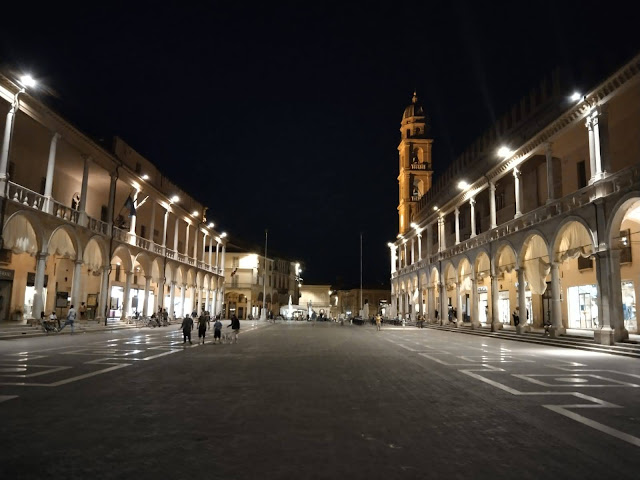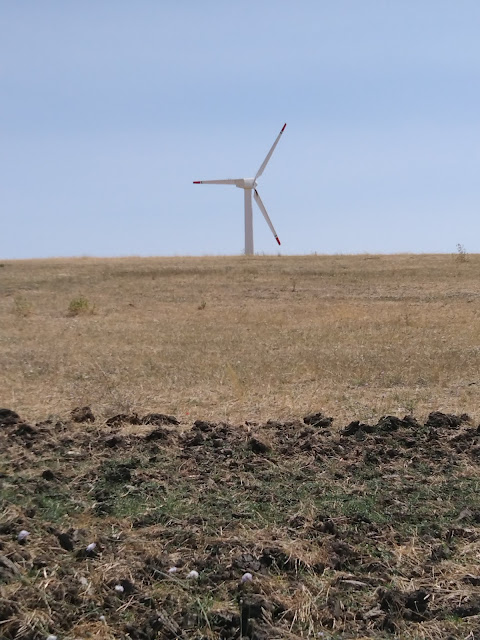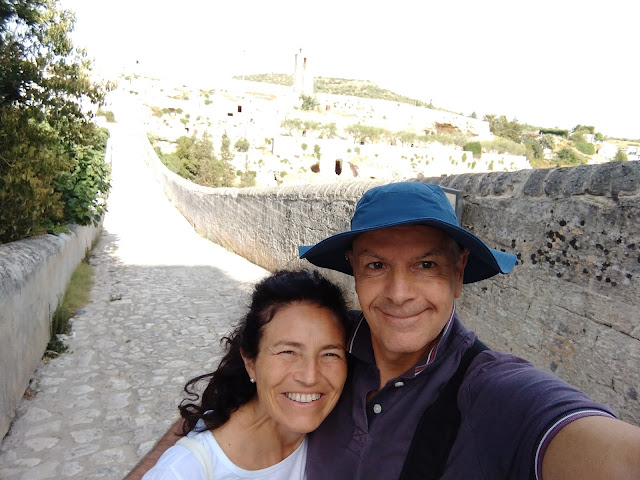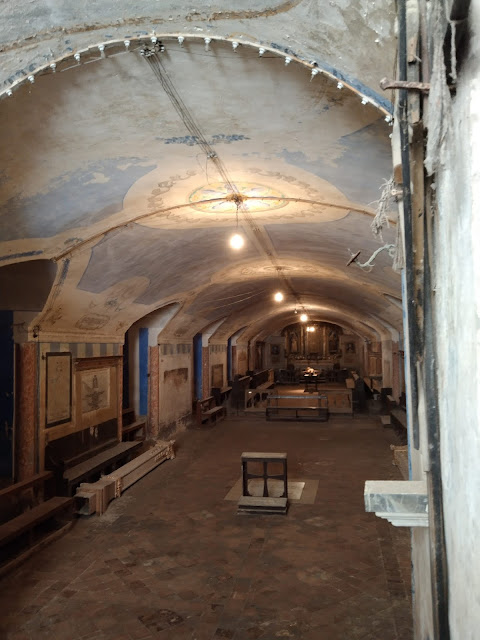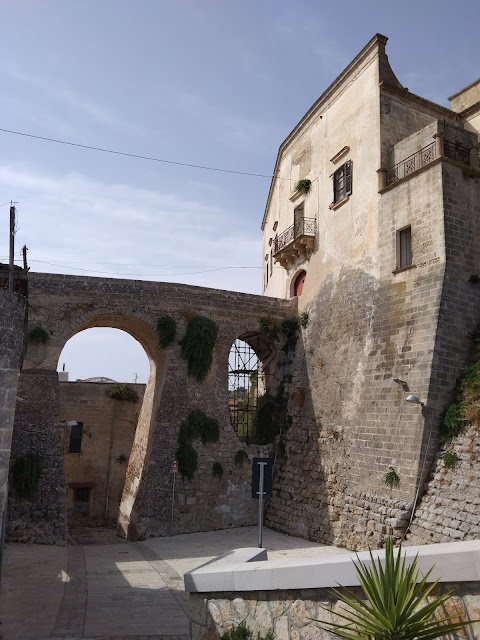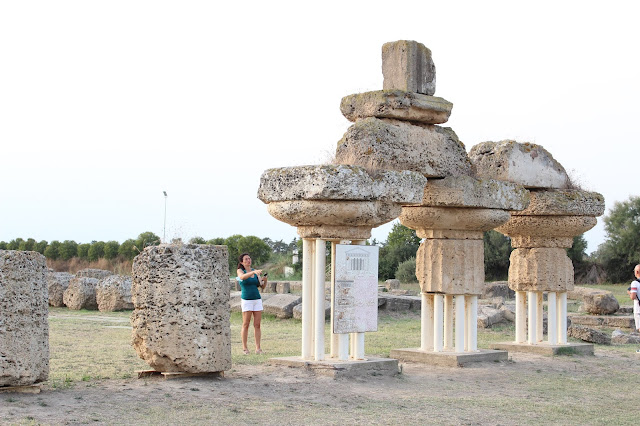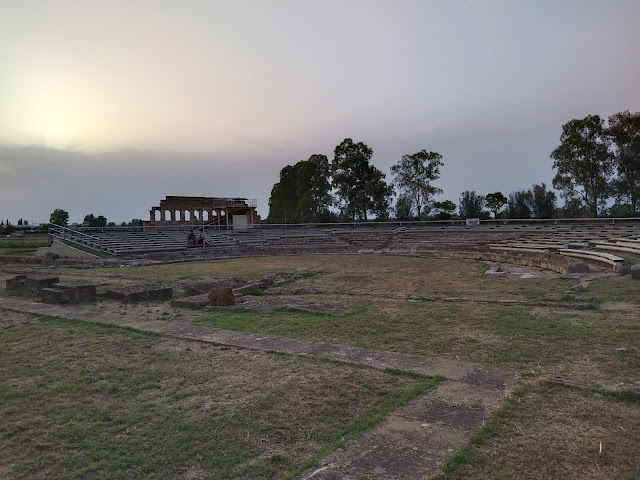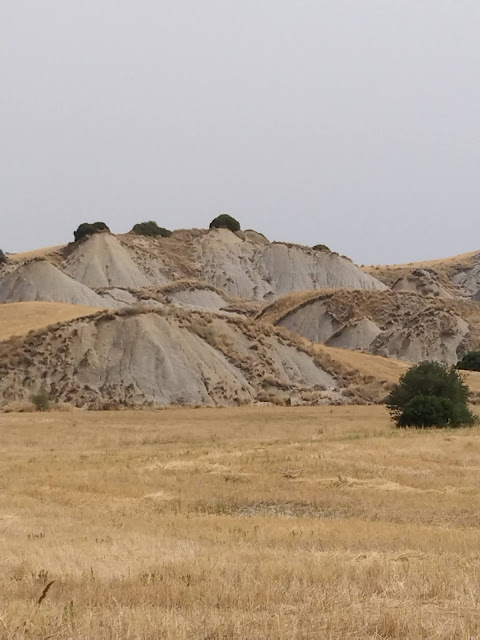Basilicata (Italy): our 13-day Basilicata summer road trip (with a short detour into Puglia & Calabria) - our detailed holiday guide
This itinerary explains our summer road trip to see the best of Basilicata with a short detour into Puglia and Calabria.
Basilicata is one of the least visited regions in Italy, except the beach seaside resort of Maratea, the only town of this region on the Tyrrhenian sea, and Matera which has become quite an attraction since 2019 when it was nominated the European Capital of Culture.
However, Basilica is still an unspoilt and undiscovered region and it has been quite hard to pick the best villages and attractions.
Our Basilicata itinerary starts off in Melfi, in northern Basilicata and winds through southernwards, ending up in Maratea, on Basilicata west coast, and includes all the beach stops on the sandy Ionian coast and on the rocky Tyrrenyan coast that we visited. We decided to skip Matera as we had visited it many times.
We decided to include also a couple of stops into Puglia, the amazing burrow area (le Gravine), as Puglia is bordering Basilicata and easy to reach. We included also Calabria, Praia a Mare in particular, as we booked late and found no suitable spots to our likings and suitable to our budget. It was very fortunate because we discovered the great Calabria! The etaste of another holiday, for sure.
Basilicata turned out to be also a great escape from the summer crowds in Italy as for some reason or another it is one of the least-known regions of Italy. It is actually still untouched by mass tourism and that is why it is so authentic and genuine: people, foods and traditions.
BASILICATA'S ROAD CONDITIONS: NEED TO KNOW
Paolo and I found out that the splendid isolation of Basilicata has a reason though.
In any case, one of the reason why Basilicata is little known to most people is clear: Basilicata is a rather difficult region to reach if you don't have a car, as train stations are not everywhere, bus connections are not many and consequently getting there takes a long time.
We found a very demanding and complex road system: the state roads and also the viaducts and bridges are not in good conditions, the secondary roads such as the provincial and farm roads are hard to drive onto due to potholes and landslides, or stretches of connecting roads to the villages are not asphalted.
Of course locals will tell you that that's not a problem as they are used to driving there; however, we found it tiring.
In short, there is an explanation for the relative isolation of Basilicata. Finally, for those who do not have a safe driving or are not used to driving in the mountains, given the slopes, the uphill and downhill roads without barriers, and the mountain hairpin bends ... well, you are warned! :-)
Despite bad road conditions, you need to take time and visit this wonderful Italian region!
Enjoy Basilicata!
BEST TIME TO VISIT BASILICATA
It was our first trip to visit Basilicata but I think that the best season is summer. July and August are simply exciting because the Basilicata villages are full of life. It’s true that summers can be very busy and hot (this summer we actually suffered a little from ... 44 degrees, burning hot!); however, even in summer in the vast countryside and in tiny villages you hardly see many tourists. What we wanted.
The best known beaches like Maratea which tend to be crowded in the summer are enjoyable all the same: you just need to climb up the hill and enjoy the sea panorama from the top! The Ioninan beach resorts such as Metaponto or Policoro were not packed and the WWW sactuary beaches were empty even on 15th August which in Italy is the peak summer season for Italians!
In winter visiting Basilicata must be fascinating as well: it used to snow heavily in the past as locals told us; however, recently snow had hardly been seen.
IS A WEEK ENOUGH TO VISIT BASILICATA?
Definately not! We spent almost 3 weeks touring Basilicata and Molise and still it was not enough.
Actually, Basilicata in a week is a bit of a rush: you really would need a whole month and you still would have things left to visit!
One week would be just about right to visit Maratea, Matera and possibly some seaside resorts which apart from being excellent sandy beaches, they have amazing archeo museums!
This itinerary can either be taken more slowly or can be extended to two weeks or more (we toured Basilicata in 13 days, the rest we spent in Molise), by adding a longer stay in Maratea or on the Ionian sea for more rest.
We actually wanted to visit Molise too in our summer holidays, so in another blog post I will be telling you more about our trip to Molise.
WHERE TO STAY IN BASILICATA
Paolo and I like to stop along the route on our road tours, both in Italy and abroad. We never stop too long in a base. This year we have picked either cute apartments in villages, or local B&B which have a local feel. Only once we opted for a hotel stay.
Changing spots can be tiring, but the upside is that if you want to enjoy the best attractions and you don't want to drive back and forth, that's about the only way. Unless you want to skip places, of course. Consider that road conditions in Basilicata are poor, so if you choose a base to sleep and you want to visit other places, take into account the time you will need to reach remote villages.
Choosing the coast would be definitely a good choice if you want just to relax and may be visit Puglia too. Alternatively if you love parks, the Parco Nazionale del Pollino in Basilicata, the largest in Europe, may be another good option.
84% of Basilica is covered in mountains and the rest plains and hills, so it is not easy to visit it if you use public transport: planning where to stay it is definitely important.
OUR DETAILED ITINERARY OF BASILICATA (WITH A DETOUR IN PUGLIA AND CALABRIA)
START: FAENZA, EMILIA ROMAGNA
DAY 1: FAENZA TO PORTOCANNONE (MOLISE)
PORTOCANNONE: A MOLISE VILLAGE WHERE THEY STILL SPEAK OLD ALBANIAN
CAMPOMARINO LIDO BEACH AND CAMPOMARINO TOWN GRAFFITIS
DAY 2: PORTOCANNONE TO MELFI (BASILICATA)
MELFI: THE CITY LOVED BY THE NORMANS
The first stop in Basilicata located in the province of Potenza is the town of Melfi with its stunning and huge castle, Castello di Federico II, which was the seat of four pope's councils: when popes are mentioned it is definitely an important town!
Federico II was crowned king when he was 4! The Pope Urbano III announced the First Crusade from the Castle of Melfi! Robert Guiscard -the Norman king- confined his wife Alberada of Buonalbergo in the Castle to marry another noble woman.
To continue with a bit of history, the Castle of Melfi was chosen by the Emperor Frederick II of Swabia as a residence and he promulgated the Melfitan constitutions in 1231: the Melfitan constitutions are the first organic text of laws drawn up in the Middle Ages and with both civil and penal relevance.
The fortress later became the home of Charles I of Anjou, king of Sicily who, in 1280, ordered some extensions. In 1531 the emperor Charles V donated the fief of Melfi to Andrea Doria, you know the famous Genoese family and statesman as well as sea admiral who was given it as a reward for the services rendered in his favor.
Between the sixteenth and eighteenth centuries the castle of Melfi was transformed into a noble residence of the Doria family. About 4 centuries had to pass before the castle of Melfi ceased to be a fief of the Doria and passed to the Italian State on April 24, 1954.
What you can't miss in the wonderful castle is the National Archeo Museum "Massimo Pallottino": there is a beautiful sarcophagus called the Melfi Sarcophagus or Rapolla's Sarcophagus topped with a sculpture of a stunning girl.
We do not know who exactly the woman in the sarcophagus of Rapolla was, but she must have been much loved and whoever was his lover, he must have soothed the tears by looking at the beautiful image of the girl lying softly on the death bed as if she were still alive.
According to the prevailing interpretation, the young woman depicted on the lid is Emilia Sauro, daughter of Cecilia Metella who married Pompeo but died in childbirth immediately after the wedding. In honor of the deceased, the sarcophagus was therefore commissioned in Asia Minor.
The young woman belonged to the gens Cornelia who moved in part to Venosa, where she had many possessions, at the time of Roman colonization. The sarcophagus was therefore deposited in a villa in the Venosa countryside of the time..
I have a very nice memory of an old men whilst we were leaving Melfi. He could have been 80 or 100, of an indefinate old age. He was an old man, but I could see the young boy in him still yearning to return to his gift giving game.
While we passed by he was sitting on the sill of his vegetable shop. He offered me a branch of sage and a mix of spices. He was not trying to sell them to me.
It was as if his soul sat down at one of those little gifts. Or maybe that inner boy waited for a time to put down the mask of age resilience and be himself all over again, playful. I could see his wrinkled lines and how they made crosses with those of child's joy.
TWO VOLCANIC LAKES OF MONTICCHIO: THE "SWITZERLAND" OF BASILICATA IS HOME TO THE BRAMEA BUTTERFLY
From Melfi, we drove about 20 minutes to reach the lakes of Monticchio, the volcanic area which is called the Switzerland of Basilicata. They are set in a natural relaxing place in the middle of the Vulture forest.
The two lakes of Monicchio are set in the Vulture area which is home to a rare endemic moth called "Bramea". The Bramea butterfly found climatic conditions similar to those of the Cenozoic era in which it proliferated and that is why they call it "the living fossil".
The lakes of Monticchio are a sort of Eden, and the Bramea butterfly can lead a shy life, thanks to the coexistence with a particular species of ash that grows in the humid climate of this area and whose foliage nourishes the butterfly.
The Monticchio Lakes are one of the "Places We Love" campaign supported by the FAI, the Italian Environmental Fund, which has identified several projects to safeguard the place.
To reach the two Lakes of Monticchio was complicated: due to the new administrative provisions for reaching the lakes you needed to leave the car in a dusty meadow more than two kilometers from the lakes and board a shuttle bus which was packed against all anti Covid rules! 😞 The shuttle to the Monticchio Lakes was free at least!
In general though the environment is really pictoresque, the surroundings are in a state of environmental degradation and neglect!
Around the lakes there are dusty abandoned shops, lousy restaurants, the signs are partially broken and rubbish bins are broken and full... I wish loval administration would do something to safeguard this amazing volcanic environment!
Apart from the neglect, the Monticchio lakes are a place that we liked because you enter a green oasis of peace and tranquility. You leave behind the problems of everyday life, to abandon yourself to nature and let yourself be caressed by the coolness of the Vulture forest, and by the sounds of birds.
It is definitely recommended that you spend at least half a day there touring around the lakes (only the big lake can be toured) and oing up to the Abbey of San Michele Arcangelo.
THE ABBEY OF SAN MICHELE ARCANGELO, THE RUINS OF THE ABBEY OF SAN IPPOLITO AND THE RUINS OF A NORMAN CASTLE
The lakes hide special art and archeology gems, such as the Abbey of San Michele, and the ancient ruins of the Benedictine Monastery of San Ippolito, dating back to year 1000.
The majestic Abbey of Saint Michael, built in 1700, contains the rock shrine of St. Michael the Archangel with frescoes from Byzantine times, consecrated on 13th August 1059!
Inside the Abbey of San Michele, on the first two floors, there is the National History Museum of Vulture: a visit is a must for anyone who wants to know about 750,000 years of history of the volcanoes, the plants and animals of the area.
A few kilometers away, you can see the ancient Castrum Monticolorum of the Normans: the origins of the castle ruins (today in a great state of neglect) date back to the end of the first millennium, being located in a strategic position overlooking the Ofanto river valley.
Apart from the ruins of the Castle of Monticchio, around the lakes there is also the Abbey of Sant’Ippolito. The old Abbazia di Sant’Ippolito is located on the piece of land between the two Monticchio lakes, the big and the small lake, precisely on the north shore of the small lake, reachable on foot and where the shuttle bus left us.
The Abbey of San Ippolito was one of the first settlements of the Benedictine monks after the Abbey of Montecassino: the monastic complex here seems to have originated in a period prior to the Byzantine times (around the 10th century!).
But why all these castles and abbeys in this Vulture area?
Well, before the year 1000 there were inter-religious and political struggles that took place between the eastern church (with the Basilian monks) and the western Latin church (with the Benedictine monks). Florid and troubled periods, political struggles between Constantinople and Rome that also had repercussions in the South of Italy.
Between Byzantine and then Norman, Swabian and Angevin dominations; between monastic settlements, cults and pilgrimages, this area of the Vulture and the Monticchio Lakes has seen the succession of powerful rulers and the church to indicate its strategic importance.
One of the things that struck me are the incredible roots of these beeches in the Monticchio lakes. They are aerial roots that emerge like many teeth, perhaps like many children we too should believe that trees if not walk, they can talk. Watching them so deep and strong they survive drought and water as they grow in a bank where water comes and goes.
WINE TASTING IN BARILE AT PATERNOSTER WINERY AND WINE TASTING
Paolo wanted to visit a winery in the local wine Aglianico wine area, in particular the Paternoster Winery in Barile for Aglianico wine tasting. The winery is located in Barile, not far from Melfi and is set in a amazing vineyards landscape.
The name of the town Barile probably derives from "barrelium", the duties imposed in ancient times on the sheep flocks. The name, they say, could also be a reference to the town coat of arms that depicts a barrel and a bunch of grapes, testifying to the production of Aglianico wine since ancient times.
In Barile you can see the cellars dug into the tuff about five centuries ago and which today are used for aging of wine. The newly refurbished "Park of the Cellars" in Barile is a wonderful scenery - consisting of about 90 caves dug into the slope north of the promontory on which Barile stands. Here in 1964 Pier Paolo Pasolini shot the scenes of the nativity and the massacre of the innocents in film "Gospel according to St. Matthew".
The view of the Aglianico vineyards exposed to the August sun, the peace of the place in the hottest hour gave our visit ... an extra touch! And Aglianico wine is just amazing! Did you know that Aglianico is nicknamed the Barolo wine of the South? Cheers!
WHERE TO SLEEP IN MELFI
Stay. We stayed here. The hotel which we found on the spot was very conveniently located near the main road. Rooms were big though a bit old fashioned and needed renovation works (room with a bathtub, not with shower, at least the one we were assigned), breakfast was ok and was served (no self-service due to anti-Covid measures); however, we found the the price expensive for what it was offered.
There is also a restaurant on site. The hotel (a four star, by the way) must have seen better times!
WHERE TO EAT IN BARILE
Eat. We were advised by Paternoster winery manager to stop and have lunch at Al Boschetto where we ate the typical pasta, strascinati, and Aglianico wine of course!
The strascinati, a type of pasta similar to similar to orecchiette but larger in size, have a simple preparation based only on water and flour and are a first course, especially if served with the typical peperone crusco, crunchy pepper, and cacioricotta!
Though very busy at lunchtime, the service was super quick! Excellent trattoria of you visit Barile!
WHERE TO EAT IN MELFI
We had dinner at Macelleria Braceria Rauseo: excellent! Try bombette, grilled meat and spit! Always book in advance.
DRIVING DISTANCES AND TIME
Melfi to Monticchio Lakes: 30 minutes.
Monticchio Lakes to Venosa: 40 minutes.
OPENING TIMES
MELFI ARCHEOLOGICAL MUSEUM:
Time: every day from 9 AM until 7:30 PM. Ticket: 2,50 euro. Ask the cashier at museum for a combined ticket with Venosa museum!
ABBEY OF SAN MICHELE ARCANGELO AT MONTICCHIO LAKES
Time: in the summer open every day from 9 AM until 8 PM. Free of charge.
NATURAL HISTORY MUSEUM OF VULTURE
Time: Tuesday, Friday and Sunday from 9 AM to 1:30 PM and from 2:30 PM to 5:30 PM; the rest of the week: from 9 AM to 1:30 PM. Monday closed. Charge: 3 euros. Phone before going.
Melfi: Municipality Website.
DAY 3: MELFI TO GRAVINA DI PUGLIA (PUGLIA)
VENOSA: THE CITY OF THE TEMPLAR KNIGHTS AND OF THE POET HORATIO
In the morning we left Melfi for Venosa, our next destination in Basilicata.
Venosa is located in the Vulture area, in the north of Basilicata on a plateau, so to get there we go past two valleys with beautiful rural landscapes and many, many many ... hills and with a considerable difference in height along deserted streets in the middle of nowhere.
In the end when you get to Venosa you are at about 400 meters above sea level, but before you will have had a good deal of hilly ups and downs!
Venosa is one the most beautiful villages in Italy and you can start exploring the castle which has a Reinassance look thanks the adventurer, a duke called Pirro del Balzo. Inside its walls there is a very interesting archeo museum.
If you take a walk on the castle walls you can see the twon streets, and the stone palaces decorated with flowery balconies and craft shops.
And you cannot miss Horace's house, the Poet of the Odes whose statue is on display and is erected in the homonymous square.
And his Odes have been written on the walls all over the town. Though his supposed house today is just simple stone walls, squeezed between houses, the place is very pictoresque, as always the birthplaces of great names of the past are.
In front of that stone house, half battered (it was closed like many interesting sites in Italy!) you understand well the themes of the Odes of the great poet Horace, the "Carpe Diem or Seize-the-day" theme: the central theme is represented by the time that passes and you cannot stop it!
The young Horace sensed death and wanted to enjoy life, the old Horace sums up his own existence, looking for a way not to die completely. And he has succeeded if people still come here to Venosa to pay homage to him ...
Apart from Horace's Odes, around the town of Venosa you can also see murals overlooking the burrow area...
Going back to the Venosa Castle, the most attractive part is the wonderful Venosa National Archeological Museum Mario Torelli located in the castle.
I recommend you to visit the Archaeological Museum of Venosa as the quality and the variety of the finds and their historical (eg the epigraphic section) and artistic (Diadumeno's head) value arouse emotion. At least it did in me.😊
The setting is surprising and newly renovated: for example, with the help of videos you are shown the different phases of the settlement of the Romans in Venusia (this was the name of the town given by the Romans), and the region.
Apart from the museum, only a small external part of Venosa's Castle can be visited though (walkway, loggia and square). Admission is very cheap € 2.50 and you save by purchasing the combined ticket for the visit of the Melfi Museum. Green pass needed in all museum in this period (2021).
VENOSA'S ARCHEO PARK AND THE UNFINISHED CHURCH OF HOLY TRINITY
Out of town, not very far, you cannot miss the Venosa archeo park, dotted with Roman baths, Roman houses and ruins which dates back to early Christians and medieval ages.
Highlights of the Roman era are the thermal complex, divided into different environments such as the "frigidarium" which is the cold pool, consisting of a floor mosaic depicting marine animals, and the "calidarium" which is the hot pool, the hot bath with small brick pillars under which they put the wood to warm pool water up.
Another important building of the area is the amphitheater. Elliptical in shape, it was developed on three floors: about 10,000 spectators would fit. Today it is possible to see part of the perimeter and the masonry walls.
The unfinished walls of the so-called Incompiuta di Venosa, the unfinished abbey of Venosa, are amazing!
As everybody can see it is the extension of another church, the Church of the Holy Trinity.
Together the unfinished and finished churches are called the complex of the Holy Trinity, which was recognised as a national monument since the late 1800s.
The unfinished abbey is a non-place, with its amazing historical value because the erected walls are not made with simple bricks, but were built by using stone, bricks and decorations from previous eras and buildings.
The complex has uncertain origins, but the most common theory is that it was the Benedictine order that built it before the arrival of the Normans in the area.
The site housed before a pagan temple, on which an early Christian basilica was built around the fifth century. In the year 1059 the Ancient church was consecrated, while the adjacent abbey began to be built in 1100.
If the church houses several works from the Greco-Roman age, the abbey was built with materials from various other monuments and ancient sites. Therefore, there are details of Roman and Lombard origin, even elements of the Jewish faith from pre-existing houses and buildings
But why was the monastery area never completed?
It is assumed that the economic conditions of the Benedictines made it impossible to continue the building, which over time slowed down and then stopped.
With Pope Boniface VIII, the Benedictine order had to leave the area due to the suppression of the monastery. The complex was intended for the Knights of Malta, who, however, did not consider it important to be finished.
From an architectural point of view, the abbey never saw the light, but as regards the fragments of monuments it incorporates, it is a small open-air museum. Bas-reliefs, ornaments, stelae and engravings make this unfinished church unique.
In the nearby-church you can see the tomb of Alberada of Buonalbergo. Do you remember the first wife of Robert Guiscard, the Norman king, whom he isolated in Menfi's Castle to remarry another woman?
What you can see there is also the tomb of the king hmself, Robert Guiscard, the Norman guy who came to Italy to conquer Calabria and became leader of his people and an ally of the Pope but was killed later in Greece and buried in Venosa.
The fate is strange: he wanted to get away from his first wife but he was buried close to her!!
When we left the Abbey of Venosa and the Archaeological Park, I turned around and saw the place flooded by the very hot August sun, the swallows that fluttered here and there, happy... And who can say that it was an abandoned abbey? Nature will always flourish in the Incompita Abbey of VenOsa and this is enough to make it alive.
WHERE TO EAT IN VENOSA
Eat. We had lunch at Trattoria Al Baliaggio where we dined with a great antipasto and had a great Aglianico (vinified white). You will definitely find the Lucanian cuisine revisited in a modern way here. Ciambotta in different textures, Carbonara revisited with the use of Caciocavallo in fondue and Peperone Crusco, are just examples of how creative the cuisine proposed by the chef is. Good!
Ah, by the way: did you know that the Ciambotta from Basilicata is a dish of peasant origins made of peppers, aubergines, potatoes, courgettes, onions, cherry tomatoes; it is cut into small pieces and cooked in a pan with the addition of tomato sauce and basil, similar to the Sicilian caponata but richer...
AMAZING YELLOW AND BLACK LANDSCAPE BETWEEN VENOSA AND ACERENZA
On the drive that goes from Venosa to Acerenza you pass an incredible country landscape with the yellow colors for the wheat and black as the land is burned by the farmers after the harvest.
The deep yolk yellow in the heat and the strong light, the harsh black marking the boundaries with the cultivations and a deafening silence but for the whispers of the wind and the wind mills told us that this was the first of many amazing moments we would have in Basilicata.
Take a look!
From Venosa to Acerenza there are about 50 km of countryside.
Basilicata is definitely the granary or the grain store of Italy.
The countryside between Venosa and Acerenza, our next stop, beckoned. It was another day of sunshine. The hills rolled like a casually laid eiderdown quilt, rising and falling in soft waves. We drove up the lonely paths and country roads, our senses soaking in the changes: villages, hills, fields.
ACERENZA: HOME TO THE HOLY GRAIL (MAY BE😂) AND DRACULA'S DAUGHTER
And after all these wheat and grain fields and all this driving up and down the hills, we reached our destination: Acerenza!
We came here out of curiosity because it takes a lot of curiosity to go there with 40 degrees... But who made us do that?
Well, the curiosity to find the Holy Grail in Acerenza, of course.
In Acerenza we came in search for the Holy Grail 😉
Well, when we got there it was really hot and stifling and there was literally no one around, just us and a couple of tourists...
In this hamlet of two thousand inhabitants, one of the most beautiful villages in Italy, according to the Lucanians, and according to experts on the subject, the Holy Grail is hidden.
The Holy Grail is the legendary chalice from which Jesus drank at the Last Supper and which was used by Joseph of Arimathea to collect the blood from Christ's side after the crucifixion.
The Holy Grail would have the power to give eternal life and knowledge to anyone who had it.
It would be found here, but no one knows where exactly: people mention the Cathedral of Santa Maria Assunta and San Canio Vescovo.
So here we go, Cathedral of Acerenza!
The Acerenza Cathedral is medieval in origin and it sits on top of a cliff, surrounded by the vineyards of Aglianico wine. The weird thing is that the village is tiny today, but the Cathedral is the largest church in the area, capable of hosting 1200 people!
Why is the Cathedral of Acerenza huge?
The Cathedral building was started by Archbishop Arnaldo towards the end of the 11th century; during the works the relics of the martyr bishop San Canio were found. However, today there is no trace of these or others and this makes us easily understand how the possession of the relics since those times was a promotional tool, to increase the prestige and wealth of Acerenza.
The imposing monument is in the Romanesque-Norman style, or rather Romanesque-Cluniac due to the imprint given by Arnaldo, who had been Abbot of Cluny and used of French architects. It was he who consecrated it in 1080 to S. Maria Assunta and S.Canio.
However, it is quite a special church: there is no traditional cross in the Church whilst you can find the bust of Julian the Apostate, persecutor of Christians.
And there is a super mysterious crypt downstairs: people think that down there behind a small window which was barricaded 500 years ago there is the Holy Grail chalice.
We came out of the crypt and the Cathedral of Acerenza a bit astonished to say the least.
Acerenza boasts to be home to the Holy Grail, the famous biblical chalice, which was allegedly brought here by the founder of the Order of the Knights Templar, Ugo dei Pagani. In fact, Acerenza has been identified as a place of passage and rest for Crusaders traveling to or from the Holy Land.
The search for the Holy Grail has not borne fruit during out visit, but it seems to me that it was enough to have discovered this cathedral so unique and different ... and anyway, apart from Acerenza, the search for the Holy Grail continues as many films like Excalibur, Indiana Jones and the Last Crusade or the Da Vinci Code have shown: man has always had this thirst for knowledge and power given by the elusive Grail, whether it be a chalice or a stone in Acerenza or anywhere else.
IRSINA: THE CAVE-HOUSES, OF THE SCROVEGNI CHAPEL OF THE SOUTH AND OF MANTEGNA'S SAINT EUPHEMIA WOODEN STATUE
The next stop was Irsina, a village on the border between Puglia and Basilicata, which is one of the oldest villages in Lucania.
Irsina means steep, perched and you understand why because the village seems suspended on the rocks. It is a particular town: founded in the Greco-Roman era, until February 1895 it had another name, Montepeloso, from the Greek plusos (rich and fertile land).
The next sight we visited was the amazing San Francesco Church and its frescoes.
In the frescoes of the underground chapel, created inside the tower of the Norman castle, the reference to Giotto's painting is clear not only in the architecture but also in the spirituality of the characters.
The clients of this masterpiece was the Del Balzo family who had an important role in promoting artists, and shows all the themes dear to fourteenth-century painting: from the depiction of the Creator to the Crucifixion, from the Last Supper to the Presentation in the Temple.
I call the place Giotto's Scrovegni Chapel of the South. Though the Padua-based Scrovegni Chapel is a wok of art, the frescoes here too are stunning!
The frescoes dates back to a period between 1370 and 1373. The chapel, frescoed by unknown artists close to Roberto d'Oderisio, the most famous of the Neapolitan Giotto-like painters, shows multiple influences of the Florentine, Sienese, Pisan, Neapolitan and Roman schools.
The figure of God the Father is depicted in the vault and is striking The representation recalls the Celtic-Irish miniatures in the gigantic and flattened face, in the long white beard and in the almond-shaped eyes close together. The Creator is surrounded by multicolored concentric circles representing the universe and is supported by four angels.
At the corners of the angels, the four evangelists: the angel of St. Matthew, the lion of St. Mark, the eagle of St. John and the ox of St. Luke.
In the center, on the pillar of the eastern wall, less damaged and more intact than the others, the most dramatic scene of the cycle is represented, the Crucifixion, which is affected by Giotto's, Sienese and Byzantine influences. Christ hangs from the cross by reclining his head on his chest and falling back with his arms and torso forward.
The tragedy of the scene is visible on the suffering face and in the two angels, depicted in rapid descent on the side of Christ.
All that fluttering of angels and the magnetic gaze of Christ in the center are more than enough if you want a valid reason to visit this magical place and Irsina.
Go there if you have the opportunity: it is Giotto's Scrovegni Chapel of the South!
Like Materia, animal shelters were also dug in the rock in Irsina as caves first, which were then transformed into houses by the locals.
The most beautiful and best preserved, now protected by the FAI (the Italian Heritage Fund) is certainly the Barbaro cave house, dug directly into two rocky caverns, which is made of two floors.
Some of these cave houses form real underground cubicles which sometimes take the shape of galleries.
For lovers of the Romanesque and Baroque style there is the Cathedral of Santa Maria Assunta. Not to be missed are the beautiful Romanesque crypt, the bell tower, the Neapolitan baroque facade with a richly decorated portal.
Among the noteworthy works of art inside, do not miss the baptismal font in red marble and the wooden crucifix of the Donatello school, both from 1454, and the beautiful statue of St. Euphemia, recently attributed to Mantegna.
In the adjacent sixteenth-century convent there is the Civic Museum, Museo Janora, with the archaeological collection of over 1600 objects, donated to the city by the Irsinia historian Michele Janora.
Another special thing in Irsina are the so-called "bottini", underground tunnels where the water is flowing: the Bottini were conceived in medieval times to feed the springs of Irsina.
They are underground tunnels with barrel vaults (hence the term) carved by hand into the rock that develop in a maze of tunnels and water collection tanks and drain the groundwater collecting it at the bottom of canals.
We would have liked to continue wandering through the alleys of Irsina, but the lady of our B&B in Gravina, our next destination, was waiting for us ... and we could not miss the appointment with the next incredible stage of our tour, encroaching on Puglia.
Wait for us Gravina and goodbye Irsina!
ON THE ROAD: HILLY LANDSCAPE BETWEEN IRSINA AND GRAVINA DI PUGLIA
On our road tour this was the amazing landscape between Irsina and Gravina!
GRAVINA IN PUGLIA (PUGLIA): A DETOUR TO VISIT THE ROCK CHURCHES AND THE ROMAN BRIDGE DEAR TO ...J AMES BOND!
The aim for our tour was Basilicata, but as I had missed in Puglia a visit to Gravina di Puglia, well...I could not skip it this time as we were bordering Puglia.
I did not know that in the film "No Time to Die" James Bond 007 had jumped from the Aqueduct Bridge of the Madonna della Stella in Gravina in Puglia!
Looking down from the top of its 37 meters, well ... he definitely did not suffer from vertigo! The Ponte della Gravina or Ponte dell'Acquedotto is 90 metre long and connects the two banks of the Gravina river. Gravina means in fact ravine.
The bridge was built to allow the crossing of the Crapo (the ancient name of the Gravina stream), and allow the people to reach the church of the Madonna della Stella. This very ancient bridge collapsed with the earthquake of 1686 and it was therefore the Orsini family from Rome, who had moved to the fief of Gravina, to turn the bridge into an acquedyct around the middle of the eighteenth century, to convey the water from the underground springs.
The Orsini's were a powerful family that gave birth to Pope Benedict XIII also known as the Pope Friar because a man close to the people and loved because in Rome he had the hospital for the poor built. He was born in Gravina and not to disturb the Roman citizens when he died he ordered that the death bells not be rung.
The monument which is linked to he Pope is the Cathedral of Santa Maria Assunta: magnificent and imposing, the cathedral was originally built by the Normans, only to be rebuilt at the end of the 15th century, following damage by an earthquake.
Continuing east we arrived at the medieval bastion that defended the city from external attacks and after that you reach the historic center developed around three districts and the ravine of the Gravina canyon.
The ravines were formed thanks to the waterways, which over time have dug the territory to create large inlets. The stream flows inside.
And the river has always been a vital element in the history of the city and ever since it was called Sidion with the Greeks and Silvium with the Romans. With these in particular it became a military station which served to supply the marching armies.
And I imagine that since then, in case of attacks, the inhabitants have taken refuge in its famous caves carved into the rock. Even today you can admire rock sites such as the Cave of the Seven Rooms and the many rock churches such as the church of San Michele delle Grotte entirely excavated in the tuff walls, probably dating back to the eighth century.
We were able to visit the cave church of Santa Maria della Stella by calling the number available directly on the access gate to the church. The church is better known with the name of Madonna della Stella (Mary of the Star), so called because of a fresco of the Madonna and Child with a star on the forehead was found.
The church-cave is located on the right side of the ravine, in an evocative setting near the archaeological site of Ethernal Father. Probably used in pagan times, only in the sixteenth century it became a shrine to the Virgin Mary.
It was considered as miraculous Madonna, so the number of sick pilgrims, and sterile women would flow into the sanctuary to pray: it was kept open one day and one night, once a year, for prayers.
However, due to a desecration the sanctuary lost all the benefits and was closed.
Dug out of the tuff right on the edge of the Gravina, it is accessed through small gardens.
From its garden of olive trees and caper plants, you can enjoy a wonderful view of the ravine, the bridge and the cathedral!
Another beautiful palace in Gravina we were lucky to visit is the Bishops's Palace, located in Piazza Benedetto XIII, where there is a statue dedicated to the pope of the same name that I mentioned earlier.
The Palace was built in the 9th century AD, but collapsed together with the Norman Castle, the Cathedral and many churches, towers and houses during the 1456 earthquake and was rebuilt afterwards.
A place not to be missed is the Finya Library, the oldest in Puglia tthat we visited together with the Cathedral and the Bishop's Museum in a super interesting tour!
It is one of the oldest public libraries in Puglia, and could be defined as a real temple of knowledge and culture, strongly desired and enriched by enlightened representatives of the local clergy.
The most substantial donation from the point of view of the books and financial heritage is down to the cardinal from whom it takes its name, Francesco Antonio Finy (1669-1743), a close collaborator of Pope Benedict XIII.
The main element of the library is the large consultation room, similar to a medieval "scriptorium", typical of monasteries, characterized by large windows located in the upper part of the building to ensure optimal lighting, and exploiting natural light as long as possible.
The library has over 20,000 volumes, of which 12 incunabula, about 437 editions of the sixteenth century and over 8000 of the seventeenth, eighteenth and first thirty years of the nineteenth century, a precious illuminated manuscript.
A team of volunteers from the Cathedral are trying to bring to light and archive and file thousands of books, a daunting task as they tried to explaint to us.
If many of the beautiful posts in Italy are accessible today it is also thanks to the volunteer work of many kind-hearted people!
Our visit to Gravina continued exploring churches such as that of San Francesco and Santa Lucia, and the Cola Cola house-museum, the traditional whistles of Gravina in Puglia.
At the end of our day we understood why Gravina conquered us: it has a unique landscape and offers fascinating scenarios, which alternate pastures, rocks and art.
Just like the sweet gaze of that Madonna of the Star remains inside you, in the soul.
WHERE TO SLEEP IN GRAVINA IN PUGLIA
We spent the night at a bed and breakfast with a stunning view over the bridge and the burrow. Fantastic! Here.
WHERE TO EAT IN GRAVINA IN PUGLIA
A lovely modern restaurant near the bridge: we loved the farmer's appetizer consisting of 7 courses and two tastings of first courses (assassin pasta :-) and ravioli with cacioricotta cream and taralli), all typical food and wonderfully presented and prepared. Here.
DRIVING DISTANCES AND TIME
Venosa to Acerenza: 56 minutes.
Acerenza to Irsina: 40 minutes.
Irsina to Gravina di Puglia: 25 minutes.
OPENING TIMES
VENOSA ARCHEOLOGICAL MUSEUM "MARIO TORELLI" (INSIDE THE CASTLE OF VENOSA)
Time: Monday, Wednesday to Sunday from 9 AM until 8 PM. Closed on Tuesday. Ticket: 2,50 euro. Green Pass compulsory.
CASTLE OF VENOSA
Time: open every day from 9 AM until 8 PM, except Tuesday: 2 PM to 8 PM. Ticket: 2,50 euro. Green Pass compulsory.
VENOSA ARCHEOLOGICAL PARK
Time: Monday to Sunday: 9 AM until dawn, closed Tuesday morning, open from 2:30 PM. Ticket: 2,50 euro. Green Pass compulsory.
IRSINA MUSEO JANORA
Contact these numbers and e-mail to access museum: CELL: 3356494861 / 339 4589526; EMAIL: ARENACEA@TISCALI.IT. Ticket: 2,50 euro. Website.
DAY 4: GRAVINA DI PUGLIA TO PALAGIANELLO (PUGLIA)
Reluctantly leaving the wonderful Gravina, our journey continues in Puglia through the wonderful landscapes of the Alte Murge. Our destination for today is first the village of Ginosa and after that, Castellaneta, the home town of Rodolfo Valentino.
GINOSA: PAOLO PASOLINI'S FILM SETS IN THE ROCKY CAVES
There is a not such a subtle thread that unites the history of Ginosa with that of Casarsa della Delizia: one is in Puglia and the other in Friuli. The person who binds them is Pier Paolo Pasolini, an Italian writer, actor and director from Friuli who nevertheless has always lived far from his own motherland.
He was in love with the people of the South, the poor, abandoned and forgotten by the institutions. And it is in the South, in Puglia and Basilicata that he shot his most intense films.
Ginosa was also one of her favorite film sets, so prehistoric, rural and authentic. Since Pasolini shot some scenes of his films in Ginosa, life has changed a lot ... or maybe not. Well, the peasants no longer live in caves and carved cliffs, but the landscape is still all there, like in a history book.
I managed to see from the top the 7-kilometre canyon that in some parts is even 150 metre deep, an amazing rock scenary that Pier Paolo Pasolini wanted to make it immortal in his films.
Ginosa rises on the first step of the Murge plain, along the edge of a deep ravine marked by caves, which offers protection on three sides to the Norman castle.
However, Ginosa has important finds from the Greek age, so its origin is lost in the mists of time. For the Romans it was an important center for its location close to the Roman Via Appia and for the wheat cultivation.
The rocky caves of Ginosa were inhabitated until the second half of the last century. Some examples of rock villages can be found in that of neighbourhoods called Casale or Rivolta: the houses are arranged on five levels, all connected by stairs and streets. During the past earthquakes part of them came down that is why in 1956 the head of police ordered that the houses should be cleared up.
The creation of cave houses developed in1500s: part of the house was carved out of the rocks and the rest was built with materials extracted. Many cave houses also had a tank for water conservation.
The canyon tour of Gravina could not be carried out because of the heat wave, which left us not many alternatives than to continue towards our further destination without delving into the town. The middle of the day was for siestas inviting a lazy restfulness rather than canyon walking!
Had the temperature not been quite so extreme, we would have taken the opportunity to visit Ginosa Canyon, just a short way downhill from the town. Bear it in mind.
Before driving away, I have the memory of this chair, empty, outside the door of a house in Ginosa: the empty chair would surely have hosted that same evening a lady, who would have chatted with other wives, as is the custom in the South.
In its simplicity, this empty chair waiting for someone seemed to me very "Pasolini-like", magical. The magic of places of Puglia.
CASTELLANETA: THE BIRTHPLACE OF THE SEX SYMBOL, RODOLFO VALENTINO
In the slightly cooler (still over 37 degrees) afternoon we headed down to Castellaneta before sunset.
The light on the white houses in town marked the end of a pretty excellent, albeit hot, last day in Puglia.
The ravine that surrounds the town for two thirds is the largest in the province as well as one of the largest in the whole of Puglia (it also takes the name of 'gravina grande', the big ravine).
The natural cavities, used both for dwellings and as churches-crypts, which open into the walls of the valley tell us about the origins of the town, probably outlined in the 10th century when the peasants of the nearby hamlets sheltered in the caves to escape the pirate raids.
Leaving country roads you enter the historic center of Castellaneta for the walk dedicated to Rudolph Valentino, the stage name of Rodolfo Guglielmi, the divo who was born here at the end of the 19th century.
The Sacco and Muricello districts make up a historic center with a clear medieval imprint. The Cathedral, built in 1220 (the late Romanesque bell tower recalls it) was rebuilt in the 18th century.
The nearby Palazzo Vescovile houses a beautiful sixteenth-century polyptych (Madonna with Child and saints) by Gerolamo da Santacroce. However, like Rodolfo Valentino's Museum and many places they were shut.
Apart from the beautiful Rudolph Valentino, the Apulian town is embellished with neorealist murals, the legacy of some street art festivals that took place in the past. In fact, here are the faces of Anna Magnani, Sophia Loren, Anita Ekberg, Marcello Mastroianni, Giulietta Masina in the films «Bicycle Thieves», «Sciuscià», «Rome open city». All the Italian masterpieces of Neorealism. If you have never watched them, I recommend you to do so.
And then many skits of daily life: the lady who spreads the sheets in the square from her terrace almost touching passers-by, the gentleman who watches TV in his underwear and undershirt with the window open on the ground floor of a building, the couple who arrives on a motorbike, takes off their helmets and kisses, the only cobbler in all Puglia who arranges shoes and soles for who knows, the ironing lady that prepares the shirts ... and a fresh and clean scent comes out ... in short a bit of the stereotype of the country.
Ah, yes, I forgot and the lady who puts the figs to dry covered by a lace placemat, isn't that lovely?
After an afternoon of exploring with my Rodolfo Valentino, we got to Palagianello at Masseria for the night and we watched the sun set on the fruit orchards after another day in Puglia.
DRIVING DISTANCES AND TIME
Gravina di Puglia to Ginosa: 1 hour.
Ginosa to Castellaneta: 29 minutes.
Castellaneta to Palagianello: 10 minutes.
OPENING TIMES
GINOSA OPENING HOURS
THE CASTLE OF GINOSA
Where we were there it was closed and opening hours displayed. Phone the local tourist board or email them for further news.
MOTHER CHURCH OF GINOSA
Where we were there it was closed. Phone the church or email for further news.
GINOSA CANYONS
Free visit and walks.
CASTELLANETA OPENING HOURS
RUDOLPH VALENTINO MUSEUM
Though on the website it was shown as openend in August, we got there weekday and a board said opened just at the weekend.
Phone or email Rodolfo Valentino Museum before going.
DAY 5: FROM CASTELLANETA MARINA BEACH TO BERNALDA (SIX NIGHTS IN BERNALDA)
CASTELLANETA MARINA BEACH
After much driving and visiting the last few days, today it is beach, beach and beach... with a bit of archeo visits. The first stop is the beach of Castellaneta Marina which in the province of Taranto, Puglia.
How did we find the sea and beach at Castellaneta Marina?
Following a few hours of lying down in the soft sand with very very very few tourists around, swimming and trying to escape the tiny jellyfish (yes, this year we found them in ALL Basilicata beaches!) and picnicking in the shady pine trees, we retreated back to the car when we tired of the place and decided to change seaside resort.
Castellaneta beach has fine and soft sand: it is very light and the slightly golden in color makes this beautiful beach a great destination. The vegetation of the "Borgo Pineto" pine forest and access from the dune are wonderful.
To reach the sea in Castellaneta Marina you cross Lungomare Eroi del Mare through walkaways and the vegetation all around makes it the perfect place for wild nature fans.
GINOSA MARINA BEACH
As we drive south, the second stop is Ginosa Marina beach which is a beach in the provice of Taranto, Puglia. We had visited Ginosa village the day before but the village has also the corresponding beach: from Ginosa village the beach is 20 minutes by car. Do you miss vacation on desert islands?
Well, in Ginosa Marina it feels like being on a wild place. It looks very much like Castellaneta Marina beach resort: there are wonderful natural wild vegetation between dunes, lilies and the pine forest. The water is crystal clear, so if you are looking for transparent water, Ginosa Marina will not disappoint you.
Kilometers of sand, a shallow seabed that slopes gently. The clear and clean waters of this stretch of coast have repeatedly received the Italian Wildlife and Nature Fund "Legambiente" Blue Flag award.
Even at Ferragosto (this is the name in Italy of August 15th, and all of Italy is on holiday by the sea) you can be sure that you will not find many people here and in this period of distancing and restrictions it is perfect.
METAPONTO: TEMPLE OF HERA (TAVOLE PALATINE), METAPONTO NATIONAL ARCHEOLOGICAL MUSEUM AND PARK
METAPONTO TEMPLE OF HERA
METAPONTO NATIONAL ARCHEOLOGICAL MUSEUM AND ARCHEO PARK
DRIVING DISTANCES AND TIME
Palagianello - Castellaneta Marina: 20 minutes
Castellaneta Marina - Ginosa Marina: 15 minutes
Ginosa Marina - Metaponto Lido: 20 minutes
Metaponto Lido - Museo Archeologico Nazionale Metaponto: 7 minuti
Museo archeologico Nazionale Metaponto - Parco Archeologico di Metaponto: 6 minuti
Parco Archeologico Nazionale di Metaponto - Tempio di Hera/Tavole Palatine: 10 minuti
OPENING TIMES
METAPONTO ARCHEOLOGICAL MUSEUM: Monday, 14.00-20.00; Tuesday-Sunday, 9.00-20.00
ARCHEOLOGICAL PARK: Monday-Sunday, 9.00-30 minutes before sunset; due to lack of staff, the Park could be closed without notice (this is written on the website!).
Phone or write for confirmation by calling the Museum on +39 0835/745327.
DAY 6: FROM BERNALDA TO MARINA DI PISTICCI BEACH
 |
| Aliano gullies |
 |
| Aliano - rocky caves |
 |
| Aliano |
 |
| Aliano |
 |
| Corners of Aliano |
 |
| Aliano alleys |
 |
| A mug shot of Carlo Levi when he was young |
 |
| Carlo Levi and the peasants in Aliano |
 |
| Carlo Levi and Renato Guttuso |
 |
| Carlo Levi in Aliano |
 |
| Carlo Levi and Pasolini |
 |
| Aliano and the gullies from Carlo Levi Museum |
 |
| Carlo Levi self-portrait |
 |
| Carlo Levi Museum |
 |
| Carlo Levi Museum balcony |
 |
| Aliano gullies |
 |
| View of Aliano |
 |
| Aliano graffitis |
 |
| Aliano murales |
 |
| Carlo Levi's house in Aliano |
 |
| Aliano municipality |
 |
| Aliano main square |
 |
| Aliano narrow lanes |
 |
| Balconies of Aliano |
 |
| State quinine old shop in Aliano |
 |
| Gullies in Aliano |
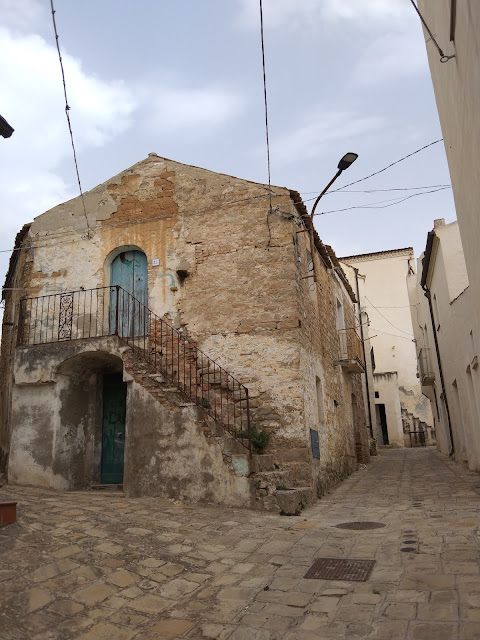 |
| Old town |
 |
| Houses in Aliano |
 |
| Board of old Aliano only public toilet in the town |
 |
| Aliano - black dressed woman sweeping the streets |
 |
| Marina di Pisticci - Cavone river beach natural reserve |
 |
| Mouth of the Cavone river, near Marina di Pisticci - the beautiful free beach |
 |
| Clear water in Marina di Pisticci - fine sand and clear water |
DRIVING DISTANCES AND TIME
Bernalda - Pisticci: 25 minutes
Pisticci - Craco: 25 minutes
Craco- Aliano: 45 minutes
Aliano-Marina di Pisticci: 50 minuti
Marina di Pisticci-Bernalda: 20 minutes
DAY 7: FROM PIETRAPERTOSA TO ALBANO DI LUCANIA
 |
| Pietrapertosa in the Lucanian Dolomites |
 |
| Lovely Pietrapertosa in Basilicata |
 |
| Street sign of Albano di Lucania |
 |
| View of the valley from Albano di Lucania |
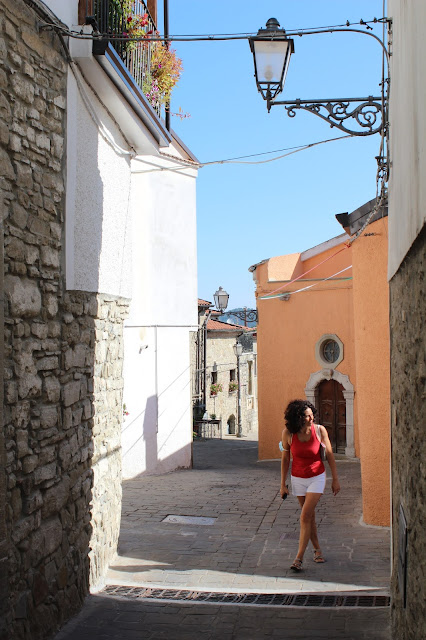 |
| Walking in Albano |
 |
| Mountain views from Albano |
 |
| Albano is full of stairs going up.... |
 |
| ....and down |
 |
| Streets of Albano di Lucania |
 |
| Cute corners of Albano di Lucania |
 |
| Street art in Albano |
 |
| Porches and hidden yards in Albano di Lucania |
 |
| Albano di Lucania and the typical red crunchy peppers |
 |
| Red crunchy peppers to dry in Albano di Lucania |
 |
| Crusco peppers to dry |
 |
| Sun dried peppers in Albano di Lucania |
 |
| Albano di Lucania - street art and kids stayue |
 |
| Main piazza of Albano di Lucania |
 |
| Locals chatting on the street in Albano di Lucania |
 |
| Albano di Lucania and the Lucanian Dolomites |
 |
| The Lucanian Dolomites seen from Albano di Lucania |
 |
| The terrace over the Lucanian Dolomites |
 |
| Church of Albano di Lucania |
 |
| Mother Church of S. Maria Maggiore in Albano |
 |
| Cute interior of the Church |
 |
| More street art in Albano |
 |
| Quiet Albano |
 |
| Sun dried peppers everywhere in Albano |
 |
| Observatory in the centre of Albano |
 |
| View of Castelmezzano |
 |
| The Lucanian Dolomites from Castelmezzano |
 |
| Castelmezzano in Basilicata looks like a crib |
 |
| Castelmezzano and the Lucanian Dolomites |
DRIVING DISTANCES AND TIME
Bernalda - Pietrapertosa: 60 minutes/ 1 hour
Pietrapertosa - Albano di Lucania: 40 minutes
Albano - Castelmezzano: 27 minutes
Castelmezzano-Pietrapertosa: 30 minutes
WHERE TO EAT IN CASTELMEZZANO
We enjoyed Trattoria Spadino; we opted for an appetizer, and pasta with cruschi (crunchy) peppers. All delicious and washed down with still red Aglianico house wine. Then coffee and bitter ricotta mousse. Absolutely super recommend also the price and quality!
DAY 8: BERNALDA - TURSI - NOVA SIRI MARINA BEACH - POLICORO WWF SANCTUARY BEACH - SCANZANO JONICO BEACH - BERNALDA
DRIVING DISTANCES AND TIME
Bernalda - Lago di Pietra Pertusillo: 25 minutes
Lago di Pietra Pertusillo - Scansano Jonico: 25 minutes
Scansano Jonico - Policoro: 45 minutes
Policoro - Bernalda: 50 minuti
DAY 10: BERNALDA - VALSINNI - SENISE - SCANZANO JONICO - BERNALDA
DRIVING DISTANCES AND TIME
Bernalda - Valsinni: 45 minutes
Valsinni- Senise: 20 minutes
Senise - Bernalda: 60 minutes
DAY 11: BERNALDA - PRAIA A MARE (CALABRIA - 2 NIGHTS) - ISOLA DI DINO
DRIVING DISTANCES AND TIME
Bernalda - Praia a Mare: 2 hours, 120 minutes
Praia - Santuario Madonna della Grotta: 2 minutes
Praia a Mare - Maratea: 30 minutes
